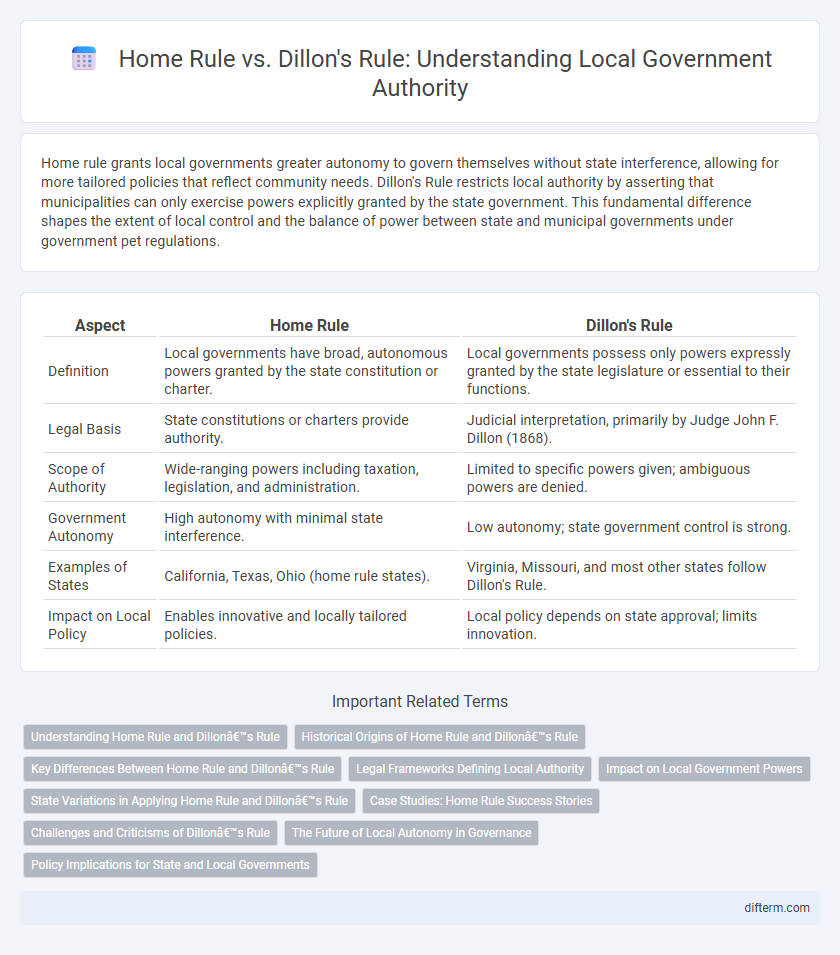Home rule grants local governments greater autonomy to govern themselves without state interference, allowing for more tailored policies that reflect community needs. Dillon's Rule restricts local authority by asserting that municipalities can only exercise powers explicitly granted by the state government. This fundamental difference shapes the extent of local control and the balance of power between state and municipal governments under government pet regulations.
Table of Comparison
| Aspect | Home Rule | Dillon's Rule |
|---|---|---|
| Definition | Local governments have broad, autonomous powers granted by the state constitution or charter. | Local governments possess only powers expressly granted by the state legislature or essential to their functions. |
| Legal Basis | State constitutions or charters provide authority. | Judicial interpretation, primarily by Judge John F. Dillon (1868). |
| Scope of Authority | Wide-ranging powers including taxation, legislation, and administration. | Limited to specific powers given; ambiguous powers are denied. |
| Government Autonomy | High autonomy with minimal state interference. | Low autonomy; state government control is strong. |
| Examples of States | California, Texas, Ohio (home rule states). | Virginia, Missouri, and most other states follow Dillon's Rule. |
| Impact on Local Policy | Enables innovative and locally tailored policies. | Local policy depends on state approval; limits innovation. |
Understanding Home Rule and Dillon’s Rule
Home Rule grants local governments the authority to self-govern and manage local affairs without needing state approval, fostering greater autonomy in decision-making. Dillon's Rule restricts local governments by mandating that they only exercise powers explicitly granted by the state legislature, ensuring tighter state control over municipalities. Understanding the distinction between these doctrines is essential for analyzing the balance of power in state-local government relations.
Historical Origins of Home Rule and Dillon’s Rule
Home rule originated in the late 19th century as a response to increasing demands for local autonomy, allowing municipalities to govern themselves with authority granted directly by state constitutions or statutes. Dillon's Rule, established by Judge John Forest Dillon in 1868, restricts local governments to powers explicitly granted by the state legislature, emphasizing state supremacy over municipalities. The historical development of home rule reflects a shift toward decentralization, contrasting with Dillon's Rule's emphasis on centralized state control.
Key Differences Between Home Rule and Dillon’s Rule
Home rule grants municipalities the authority to govern themselves with broad legislative powers, allowing local governments to pass laws tailored to their specific needs without requiring state approval. Dillon's Rule restricts municipal powers strictly to those explicitly granted by the state government, limiting local autonomy and subjecting local laws to state oversight. Key differences include the scope of local authority, the necessity of state authorization, and the degree of flexibility allowed in local governance under each rule.
Legal Frameworks Defining Local Authority
Home rule grants local governments broad authority to govern themselves independently within constitutional limits, enabling them to enact laws and policies tailored to their communities. Dillon's rule restricts local authority to powers expressly granted by the state legislature or those necessarily implied, limiting local autonomy. Legal frameworks under home rule emphasize local self-governance, while Dillon's rule reinforces state supremacy and centralized control over municipalities.
Impact on Local Government Powers
Home rule grants local governments broad authority to govern themselves and enact ordinances without state interference, enhancing local autonomy and responsiveness to community needs. Dillon's rule restricts local government powers to only those explicitly granted by state law, limiting their ability to address unique local issues independently. This fundamental difference shapes the scope of local governance, influencing fiscal decisions, regulatory policies, and administrative flexibility across municipalities.
State Variations in Applying Home Rule and Dillon’s Rule
State variations in applying Home Rule and Dillon's Rule significantly impact local government autonomy across the United States. States like California and Colorado grant broad Home Rule authority, allowing municipalities greater self-governance and legislative power, whereas states such as Virginia and New York predominantly apply Dillon's Rule, restricting local governments to powers explicitly granted by the state legislature. These differing legal frameworks shape the capacity of local entities to address community-specific issues and influence state-local government dynamics.
Case Studies: Home Rule Success Stories
Home rule governments, empowered by local charters, have effectively addressed urban challenges, as demonstrated by Seattle's innovative environmental policies and Minneapolis' health care initiatives. These cities leveraged their autonomous authority to bypass state restrictions, enabling tailored solutions that boosted economic growth and improved quality of life. Case studies reveal that home rule's flexibility often results in more responsive governance compared to Dillon's Rule jurisdictions, which rely heavily on state authorization.
Challenges and Criticisms of Dillon’s Rule
Dillon's Rule often faces criticism for constraining the autonomy of local governments, as it limits their powers strictly to those explicitly granted by the state legislature. This legal doctrine can result in delayed decision-making and reduced responsiveness to local needs, as municipalities must seek state approval for many actions. Moreover, the rigidity of Dillon's Rule may stifle innovation and limit effective governance at the local level, prompting calls for increased home rule authority.
The Future of Local Autonomy in Governance
Local autonomy under home rule allows municipalities broad self-governing powers to adapt policies and regulations according to community needs, promoting innovative governance and public responsiveness. In contrast, Dillon's rule restricts local authority by requiring explicit state authorization for local government actions, often limiting flexibility and growth opportunities for cities and towns. The evolving trend favors home rule adoption to enhance local decision-making, enable tailored solutions, and foster stronger civic engagement within American federalism.
Policy Implications for State and Local Governments
Home rule grants local governments greater autonomy to enact policies without state interference, fostering tailored solutions to community needs and encouraging innovation. Dillon's rule restricts local authority to powers expressly granted by the state, resulting in uniform policy implementation but limiting local adaptability. State and local governments must balance centralized control with decentralization to optimize governance efficiency and responsiveness.
home rule vs Dillon’s rule Infographic

 difterm.com
difterm.com